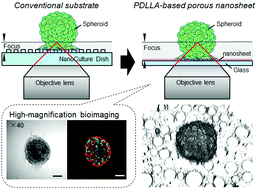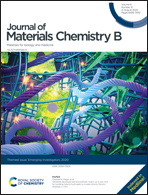Ultra-thin, transparent, porous substrates as 3D culture scaffolds for engineering ASC spheroids for high-magnification imaging†
Abstract
Three-dimensional (3D) culture is expected to reproduce biological tissues more representatively than monolayer culture, which is important for in vitro research such as drug screening. Recently, various cell culture substrates for spheroid engineering have been developed based on the prevention of cell adhesion. However, despite the expanded usability these substrates provide, they remain limited in terms of optical microscopy imaging of spheroids with high magnification lenses. This is because almost all substrates generated by nanoimprinting hamper the light passing through them owing to their low optical transparency caused by the thickness and surface structure. In this study, we achieved the preparation of spheroids from adipose-tissue derived stem cells (ASCs) on free-standing porous polymeric ultrathin films (“porous nanosheets”) consisting of poly(D,L-lactic acid) (PDLLA) with thickness of 120 nm and average pore diameter of 4 μm. ASCs migrated on the porous nanosheet, leading to the spontaneous organization of spheroids anchored via a cell monolayer. The porous nanosheet also provided more than twice the optical transparency in confocal and holographic microscopy observation compared to conventional nanoimprinted substrates for 3D cell culture (NanoCulture Dish). The internal structure of the organized spheroids could be clearly observed with 40× magnification. In addition, the engineered spheroids showed bioactivities indicated by mRNA expression of fibroblast growth factor (FGF-2) and vascular endothelial growth factor (VEGF). Thus, porous nanosheets offer a unique cell culture substrate, not only for engineering 3D cellular organization from stem cells, but also for imaging detailed structure using light microscopy.

- This article is part of the themed collection: Journal of Materials Chemistry B Emerging Investigators


 Please wait while we load your content...
Please wait while we load your content...